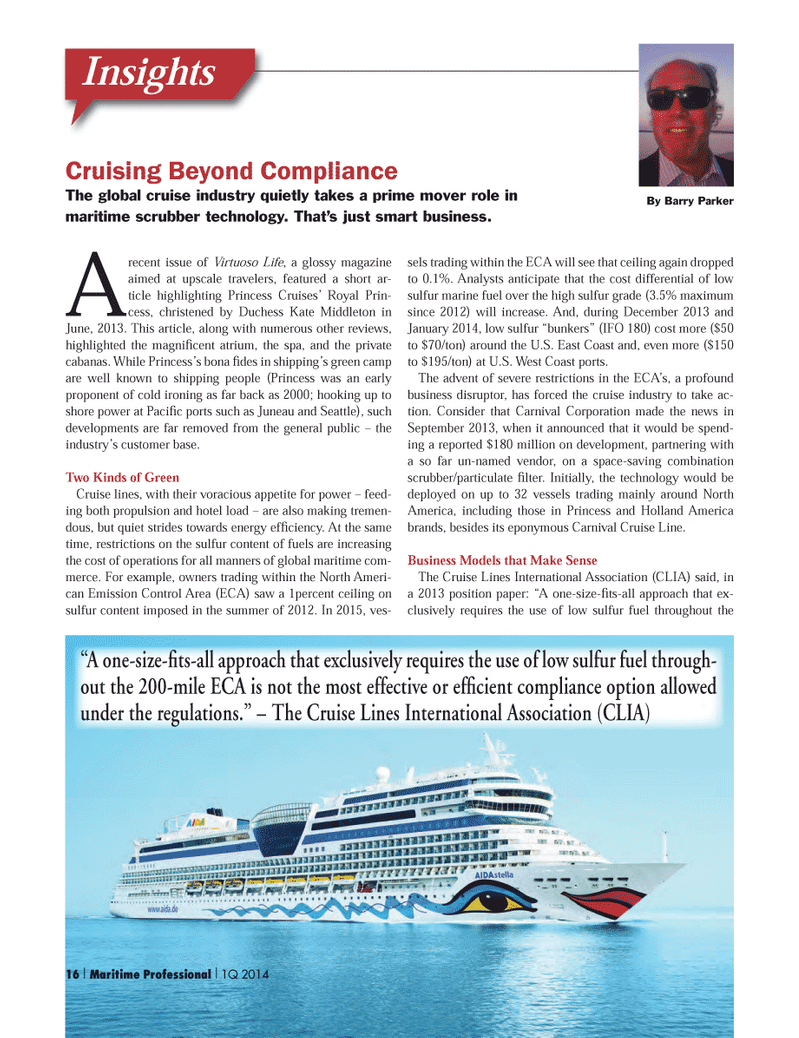
Page 16: of Maritime Logistics Professional Magazine (Q1 2014)
The Energy Edition: Exploration, Production & Transportation
Read this page in Pdf, Flash or Html5 edition of Q1 2014 Maritime Logistics Professional Magazine
Insights
Cruising Beyond Compliance
The global cruise industry quietly takes a prime mover role in maritime scrubber technology. That’s just smart business.
A recent issue of Virtuoso Life, a glossy magazine aimed at upscale travelers, featured a short ar- ticle highlighting Princess Cruises’ Royal Prin- cess, christened by Duchess Kate Middleton in
June, 2013. This article, along with numerous other reviews, highlighted the magnifi cent atrium, the spa, and the private cabanas. While Princess’s bona fi des in shipping’s green camp are well known to shipping people (Princess was an early proponent of cold ironing as far back as 2000; hooking up to shore power at Pacifi c ports such as Juneau and Seattle), such developments are far removed from the general public – the industry’s customer base.
Two Kinds of Green
Cruise lines, with their voracious appetite for power – feed- ing both propulsion and hotel load – are also making tremen- dous, but quiet strides towards energy effi ciency. At the same time, restrictions on the sulfur content of fuels are increasing the cost of operations for all manners of global maritime com- merce. For example, owners trading within the North Ameri- can Emission Control Area (ECA) saw a 1percent ceiling on sulfur content imposed in the summer of 2012. In 2015, ves- sels trading within the ECA will see that ceiling again dropped to 0.1%. Analysts anticipate that the cost differential of low sulfur marine fuel over the high sulfur grade (3.5% maximum since 2012) will increase. And, during December 2013 and
January 2014, low sulfur “bunkers” (IFO 180) cost more ($50 to $70/ton) around the U.S. East Coast and, even more ($150 to $195/ton) at U.S. West Coast ports.
The advent of severe restrictions in the ECA’s, a profound business disruptor, has forced the cruise industry to take ac- tion. Consider that Carnival Corporation made the news in
September 2013, when it announced that it would be spend- ing a reported $180 million on development, partnering with a so far un-named vendor, on a space-saving combination scrubber/particulate fi lter. Initially, the technology would be deployed on up to 32 vessels trading mainly around North
America, including those in Princess and Holland America brands, besides its eponymous Carnival Cruise Line.
Business Models that Make Sense
The Cruise Lines International Association (CLIA) said, in a 2013 position paper: “A one-size-fi ts-all approach that ex- clusively requires the use of low sulfur fuel throughout the
By Barry Parker “A one-size-fi ts-all approach that exclusively requires the use of low sulfur fuel through- out the 200-mile ECA is not the most effective or effi cient compliance option allowed under the regulations.” – The Cruise Lines International Association (CLIA) 16 I Maritime Professional I 1Q 2014
MP Q1 2014 1-17.indd 16 2/26/2014 1:19:13 PM

 15
15

 17
17
